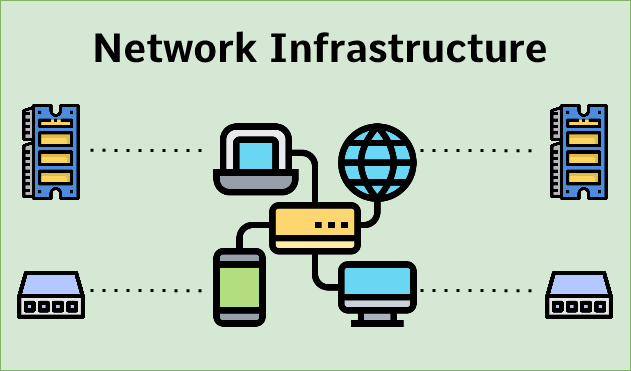Introduction
In our increasingly connected world, network infrastructure forms the backbone of our digital ecosystem. It enables the seamless flow of information, communication, and data transfer across various devices and systems. From local area networks (LANs) within homes and businesses to wide area networks (WANs) connecting multiple locations, network infrastructure plays a pivotal role in supporting our digital operations. In this article, we will delve into the importance of network infrastructure, its components, and its impact on our daily lives.
The Role of Network Infrastructure
- Connectivity and Communication: Network infrastructure facilitates connectivity and communication between devices, allowing them to share data, resources, and information. It enables seamless access to the internet, email, cloud services, and other online platforms, fostering efficient communication and collaboration.
- Data Transfer and Storage: Network infrastructure enables the transfer and storage of vast amounts of data. It provides the bandwidth and capacity required to support the growing demands of data-intensive applications, such as video streaming, cloud computing, and big data analytics.
- Reliability and Availability: A robust network infrastructure ensures reliable and uninterrupted connectivity. Redundancy measures, such as backup power supplies and alternative network paths, minimize downtime and provide continuous access to critical systems and services.
Key Components of Network Infrastructure
- Hardware Components: Network infrastructure comprises various hardware components, including routers, switches, servers, modems, and cables. These components form the physical foundation of the network, facilitating the transmission and routing of data packets.
- Network Protocols: Network protocols define the rules and standards for data communication within the network. Examples of protocols include Internet Protocol (IP), Transmission Control Protocol (TCP), and Ethernet. These protocols ensure the efficient and secure transmission of data between devices.
- Network Security: Network infrastructure encompasses security measures to protect data and prevent unauthorized access. Firewalls, intrusion detection systems, virtual private networks (VPNs), and encryption protocols are essential components of network security.
- Network Management Tools: Network infrastructure requires effective management to monitor performance, troubleshoot issues, and optimize operations. Network management tools provide visibility into network traffic, performance metrics, and device configuration, enabling administrators to ensure the network operates efficiently and securely.
Impact on Businesses and Organizations
- Enhanced Productivity: A well-designed network infrastructure facilitates seamless communication and collaboration among employees, improving productivity and efficiency. It enables shared access to files and resources, supports video conferencing, and streamlines workflow processes.
- Scalability and Adaptability: Businesses rely on network infrastructure that can scale to accommodate increasing demands. Scalable networks allow for the seamless addition of new devices, users, and applications as the organization grows. It enables businesses to adapt to evolving technology trends and changing needs.
- Data Security and Compliance: Network infrastructure plays a crucial role in protecting sensitive business data and ensuring compliance with industry regulations. Secure networks prevent unauthorized access, safeguard intellectual property, and protect customer information, fostering trust and mitigating legal risks.
- Business Continuity: Robust network infrastructure with redundancy measures helps ensure business continuity. Backup systems, failover mechanisms, and disaster recovery plans minimize the impact of network failures or outages, enabling organizations to maintain operations and minimize downtime.
Conclusion
Network infrastructure serves as the foundation of our digital ecosystem, enabling seamless connectivity, data transfer, and communication. Its impact extends to homes, businesses, and organizations, facilitating productivity, scalability, and data security. By investing in robust network infrastructure, businesses can enhance their operations, adapt to technological advancements, and ensure the reliable and secure flow of information. As technology continues to evolve, network infrastructure will remain a critical component in supporting our increasingly interconnected world.










